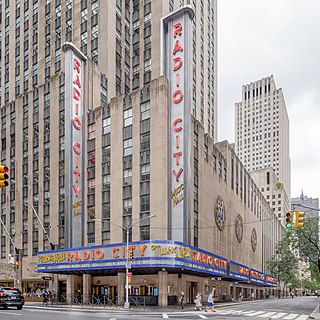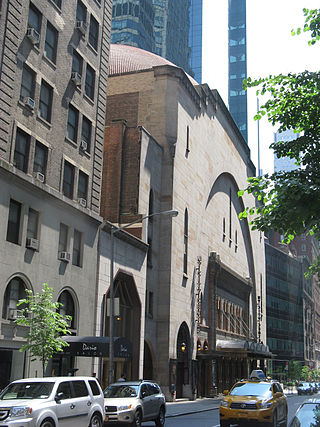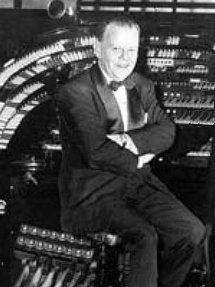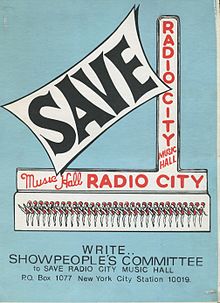
Rockefeller Center is a complex of 19 commercial buildings covering 22 acres (89,000 m2) between 48th Street and 51st Street in the Midtown Manhattan neighborhood of New York City. The 14 original Art Deco buildings, commissioned by the Rockefeller family, span the area between Fifth Avenue and Sixth Avenue, split by a large sunken square and a private street called Rockefeller Plaza. Later additions include 75 Rockefeller Plaza across 51st Street at the north end of Rockefeller Plaza, and four International Style buildings on the west side of Sixth Avenue.

Radio City Music Hall is an entertainment venue and theater at 1260 Avenue of the Americas, within Rockefeller Center, in the Midtown Manhattan neighborhood of New York City. Nicknamed "The Showplace of the Nation", it is the headquarters for the Rockettes. Radio City Music Hall was designed by Edward Durell Stone and Donald Deskey in the Art Deco style.

Lincoln Center for the Performing Arts is a 16.3-acre (6.6-hectare) complex of buildings in the Lincoln Square neighborhood on the Upper West Side of Manhattan. It has thirty indoor and outdoor facilities and is host to 5 million visitors annually. It houses internationally renowned performing arts organizations including the New York Philharmonic, the Metropolitan Opera, the New York City Ballet, the Chamber Music Society of Lincoln Center and the Juilliard School.

The New York City Landmarks Preservation Commission (LPC) is the New York City agency charged with administering the city's Landmarks Preservation Law. The LPC is responsible for protecting New York City's architecturally, historically, and culturally significant buildings and sites by granting them landmark or historic district status, and regulating them after designation. It is the largest municipal preservation agency in the nation. As of July 1, 2020, the LPC has designated more than 37,800 landmark properties in all five boroughs. Most of these are concentrated in historic districts, although there are over a thousand individual landmarks, as well as numerous interior and scenic landmarks.

30 Rockefeller Plaza is a skyscraper that forms the centerpiece of Rockefeller Center in the Midtown Manhattan neighborhood of New York City, United States. Completed in 1933, the 66-story, 850 ft (260 m) building was designed in the Art Deco style by Raymond Hood, Rockefeller Center's lead architect. 30 Rockefeller Plaza was known for its main tenant, the Radio Corporation of America (RCA), from its opening in 1933 until 1988 and then for General Electric until 2015, when it was renamed for its current owner, Comcast. The building also houses the headquarters and New York studios of television network NBC; the headquarters is sometimes called 30 Rock, a nickname that inspired the NBC sitcom of the same name. The tallest structure in Rockefeller Center, the building is the 28th tallest in New York City and the 65th tallest in the United States, and was the third tallest building in the world when it opened.
The United States of America is the home of the hip hop dance, swing, tap dance and its derivative Rock and Roll, and modern square dance and one of the major centers for modern dance. There is a variety of social dance and performance or concert dance forms with also a range of traditions of Native American dances.

The Rockettes are an American precision dance company. Founded 1925 in St. Louis, they have, since 1932, performed at Radio City Music Hall in New York City. Until 2015, they also had a touring company. They are best known for starring in the Radio City Christmas Spectacular, an annual Christmas show, and for performing annually since 1957 at the Macy's Thanksgiving Day Parade in New York.

The Ed Sullivan Theater is a theater at 1697–1699 Broadway, between 53rd and 54th Streets, in the Theater District of Midtown Manhattan in New York City. Built from 1926 to 1927 as a Broadway theater, the Sullivan was developed by Arthur Hammerstein in memory of his father, Oscar Hammerstein I. The two-level theater was designed by Herbert J. Krapp with over 1,500 seats, though the modern Ed Sullivan Theater was downsized to 370 seats by 2015. The neo-Gothic interior is a New York City landmark, and the building is on the National Register of Historic Places.
The Center Theatre was a theater located at 1230 Sixth Avenue, the southeast corner of West 49th Street in Rockefeller Center in New York City. Seating 3,500, it was originally designed as a movie palace in 1932 and later achieved fame as a showcase for live musical ice-skating spectacles. It was demolished in 1954, the only building in the original Rockefeller Center complex to have been torn down.

The Roxy Theatre was a 5,920-seat movie palace at 153 West 50th Street between 6th and 7th Avenues, just off Times Square in New York City. It was the largest movie theater ever built at the time of its construction in 1927. It opened on March 11, 1927 with the silent film The Love of Sunya starring Gloria Swanson. It was a leading Broadway film showcase through the 1950s and also noted for its lavish stage shows. It closed and was demolished in 1960.
The Christmas Spectacular Starring the Radio City Rockettes is an annual musical holiday stage show presented at Radio City Music Hall in New York City. The 90-minute show features more than 140 performers and an original musical score, and combines singing, dancing, and humor with traditional scenes. The star performers are the women's precision dance troupe the Rockettes. Since the first version was presented in 1933, the show has become a New York Christmas tradition.

The Metropolitan Opera House is an opera house located on Broadway at Lincoln Square on the Upper West Side of Manhattan in New York City. Part of Lincoln Center, the theater was designed by Wallace K. Harrison. It opened in 1966, replacing the original 1883 Metropolitan Opera House at Broadway and 39th Street. With a seating capacity of approximately 3,850, the house is the largest repertory opera house in the world. Home to the Metropolitan Opera Company, the facility also hosts the American Ballet Theatre in the summer months.

New York City Center is a performing arts center at 131 West 55th Street between Sixth and Seventh Avenues in the Midtown Manhattan neighborhood of New York City. Developed by the Shriners between 1922 and 1924 as a Masonic meeting house, it has operated as a performing arts complex owned by the government of New York City. City Center is a performing home for several major dance companies as well as the Manhattan Theatre Club (MTC), and it hosts the Encores! musical theater series and the Fall for Dance Festival annually.

La Maison Francaise, also known by its address 610 Fifth Avenue, is a commercial building at Rockefeller Center in the Midtown Manhattan neighborhood of New York City. Completed in 1933, the six-story structure was designed in the Art Deco style by Raymond Hood, Rockefeller Center's lead architect. La Maison Francaise, along with the nearly identical British Empire Building and the high-rise International Building to the north, comprise a group of retail-and-office structures known as the International Complex. La Maison Francaise and the British Empire Building are separated by Channel Gardens, a planted pedestrian esplanade running west to the complex's Lower Plaza.

The construction of the Rockefeller Center complex in New York City was conceived as an urban renewal project in the late 1920s, spearheaded by John D. Rockefeller Jr. to help revitalize Midtown Manhattan. Rockefeller Center is on one of Columbia University's former campuses and is bounded by Fifth Avenue to the east, Sixth Avenue to the west, 48th Street to the south, and 51st Street to the north. The center occupies 22 acres (8.9 ha) in total, with some 17 million square feet of office space.

10 Rockefeller Plaza is a 16-story building located on Rockefeller Plaza between 48th and 49th Streets in Midtown Manhattan, New York City. Completed in 1940, the building is part of Rockefeller Center and, like the rest of the complex, was built in the Art Deco style.

50 Rockefeller Plaza is a 15-story building located at Rockefeller Plaza between 50th and 51st Streets in Midtown Manhattan, New York City. Completed in 1938, the building is part of Rockefeller Center and, like the rest of the complex, was built in the Art Deco style.

Jennifer Jones is an American dancer and actress. In 1987, she became the first African American Radio City Music Hall Rockette.
Men Without Women is a 1932 mural by the American painter Stuart Davis executed in what the critic Hilton Kramer termed a "modified Cubist style". The work was commissioned for the Art Deco-style Radio City Music Hall at Rockefeller Center in New York City, where it hangs in the downstairs men's lounge. It was named by the Rockefeller Center art committee after Ernest Hemingway's second short story collection of the same name, which had been first published in the same year.

Richard William "Dick" Leibert was an American musician who was the chief organist at New York City's Radio City Music Hall between 1932 and 1971. He also had a radio program of organ music on the NBC Radio Network in the 1930s and 1940s, along with making phonograph recordings on the RCA Victor and Westminster Records labels.
















